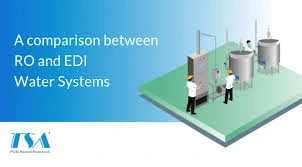Water is undeniably the most important resource on Earth. The human body is 70% water, this fact alone makes water essential for the survival of the human species. Apart from being used for consumption, water has many other attributes like polar covalence and the ability to act as a universal solvent that has made it vital to many industrial processes. However, not all water used in industries is of the same quality, some processes require the water to be purer while others do not. This demand for pure water systems has become a factor behind the innovations in pure water systems. Two major water purification systems employed in industries are Reverse Osmosis (RO) and Electrodeionization (EDI) water systems. Let’s try and understand what these systems are and what their key differences are.
Reverse Osmosis Water Systems
In simple terms, reverse osmosis water systems use partially permeable membranes to remove ions, unwanted molecules and larger particles from water. In reverse osmosis, water is run through the water with high pressure and the unwanted elements are retained in the pressurized side and pure water is allowed to pass through to the other side. To effect this, the membrane should not allow large ions or other impurities through the pores or holes, but they should allow smaller components (water/H2O molecules) to pass freely. This technique is straining, and can theoretically achieve perfect efficiency irrespective of parameters such as the solution’s pressure or concentration.
Water that is treated with the reverse osmosis purification systems is best known for its use in desalinization, but it has also been used to purify fresh water for medical, industrial and domestic applications. Globally, household drinking water purification systems, include an RO step in their purified water process. These water purification systems include a sediment filter to trap rust and calcium carbonate, an activated carbon filter to trap organic chemicals and finally the RO filter that is a thin film composite membrane. The above setup of an RO system helps the entire purification system to produce better-purified water. RO systems are also used in portable water processors and commercial water plant purification systems.
The main advantage that an RO system has over any other purification method is that it is a very low maintenance system. It is very easy to replace parts and clean the system if and when required. They improve water taste and produce highly purified water better than bottled water. The only major con of an RO water system is that it recovers only 5-15% of the water entering the system. The remainder is discharged and this creates a major problem for already water parched locations.
Electrodeionization Water Systems
Electrodeionization or EDI water systems utilize electricity, ion exchange membranes and resin to deionize water and filter dissolved ions from water. It is a very distinct water purifying method because unlike other water purification techniques it does not use chemical treatments to purify water. They use ion-exchange membranes to effectively block ions or neutral molecules and only let through certain dissolved ions.
EDI water systems are used in recycling residual water in the food and beverage industry and power plant boiler feed water. An EDI water system provides high purity water and their performance is reliable. Moreover, they use very little space and are extremely simple to use and hence require very minimal operator supervision, this factor alone makes them a perfect contender for many industrial processes where water purification systems are automated. Another major factor industries adopt EDI systems is because their performance is reliable as they ensure a constant water flow of safe water without causing any pollution.
The only limitation an EDI system poses is that they require a pre-treatment plant. This means that the water going in an Edi system needs to be pre-treated to have pure water below hardness. This is because calcium carbonate can severely affect the internal workings of the system by clogging it.
As many applications or uses there are, numerous water purification methods can be adopted to achieve the desired level of purity. That is why, choosing the right water treatment company is imperative to any industry, especially pharmaceutical processes. To do this you need to know your requirements, TSA Water Systems designs water systems for optimal purity and helps you achieve maximum operational efficiency. We strive so that your water purification systems achieve the lowest cost per liter.
Read more:
- Make an informed decision for your business by learning about the different types of water purification systems in pharmaceutical industry.






